You can make the StreamGeometry a dependency property on your custom listview, then refer to it through Binding MyGeometry, RelativeSource={RelativeSource AncestorType=ListView}.
This way, there is no ViewModel involved.


Xaml:
<Window x:Class="WpfApplication1.MainWindow"
xmlns="http://schemas.microsoft.com/winfx/2006/xaml/presentation"
xmlns:x="http://schemas.microsoft.com/winfx/2006/xaml"
xmlns:local="clr-namespace:WpfApplication1"
xmlns:s="clr-namespace:System;assembly=mscorlib"
Title="MainWindow" Height="350" Width="525">
<Window.Resources>
<!-- default lsitviewitem style except for added path -->
<Style TargetType="{x:Type ListViewItem}">
<Setter Property="Background" Value="Transparent"/>
<Setter Property="HorizontalContentAlignment" Value="{Binding HorizontalContentAlignment, RelativeSource={RelativeSource AncestorType={x:Type ItemsControl}}}"/>
<Setter Property="VerticalContentAlignment" Value="{Binding VerticalContentAlignment, RelativeSource={RelativeSource AncestorType={x:Type ItemsControl}}}"/>
<Setter Property="Padding" Value="2,0,0,0"/>
<Setter Property="Template">
<Setter.Value>
<ControlTemplate TargetType="{x:Type ListViewItem}">
<Border x:Name="Bd" BorderBrush="{TemplateBinding BorderBrush}" BorderThickness="{TemplateBinding BorderThickness}" Background="{TemplateBinding Background}" Padding="{TemplateBinding Padding}" SnapsToDevicePixels="true">
<StackPanel Orientation="Horizontal">
<ContentPresenter HorizontalAlignment="{TemplateBinding HorizontalContentAlignment}" SnapsToDevicePixels="{TemplateBinding SnapsToDevicePixels}" VerticalAlignment="{TemplateBinding VerticalContentAlignment}"/>
<!-- added path-->
<Path Stretch="Uniform" Stroke="DarkBlue" Fill="DarkOrchid" Data="{Binding MyGeometry, RelativeSource={RelativeSource AncestorType=ListView}}" />
</StackPanel>
</Border>
<ControlTemplate.Triggers>
<Trigger Property="IsSelected" Value="true">
<Setter Property="Background" TargetName="Bd" Value="{DynamicResource {x:Static SystemColors.HighlightBrushKey}}"/>
<Setter Property="Foreground" Value="{DynamicResource {x:Static SystemColors.HighlightTextBrushKey}}"/>
</Trigger>
<MultiTrigger>
<MultiTrigger.Conditions>
<Condition Property="IsSelected" Value="true"/>
<Condition Property="Selector.IsSelectionActive" Value="false"/>
</MultiTrigger.Conditions>
<Setter Property="Background" TargetName="Bd" Value="{DynamicResource {x:Static SystemColors.InactiveSelectionHighlightBrushKey}}"/>
<Setter Property="Foreground" Value="{DynamicResource {x:Static SystemColors.InactiveSelectionHighlightTextBrushKey}}"/>
</MultiTrigger>
<Trigger Property="IsEnabled" Value="false">
<Setter Property="Foreground" Value="{DynamicResource {x:Static SystemColors.GrayTextBrushKey}}"/>
</Trigger>
</ControlTemplate.Triggers>
</ControlTemplate>
</Setter.Value>
</Setter>
</Style>
</Window.Resources>
<Grid >
<local:CustomListView Margin="20" >
<local:CustomListView.Items>
<ListViewItem Content="ListViewItem1" />
<ListViewItem Content="ListViewItem2" />
<ListViewItem Content="ListViewItem3" />
</local:CustomListView.Items>
</local:CustomListView>
</Grid>
</Window>
CustomListView:
using System.Collections.Generic;
using System.Windows;
using System.Windows.Controls;
using System.Windows.Media;
namespace WpfApplication1
{
public class CustomListView : ListView
{
public StreamGeometry MyGeometry { get { return (StreamGeometry)GetValue(MyGeometryProperty); } set { SetValue(MyGeometryProperty, value); } }
public static readonly DependencyProperty MyGeometryProperty = DependencyProperty.Register("MyGeometry", typeof(StreamGeometry), typeof(CustomListView), new PropertyMetadata(null));
protected override void OnRender(DrawingContext drawingContext)
{
StreamGeometry geometry = new StreamGeometry(); // directly opening MyGeometry results in "must have isfrozen set to false to modify" error
using (StreamGeometryContext context = geometry.Open())
{
Point p1 = new Point(this.ActualWidth * (2d / 5d), 0);
Point p2 = new Point(this.ActualWidth / 2d, -10);
Point p3 = new Point(this.ActualWidth * (3d / 5d), 0);
context.BeginFigure(p1, true, true);
List<Point> points = new List<Point>() { p2, p3 };
context.PolyLineTo(points, true, true);
}
drawingContext.DrawGeometry(Brushes.DarkOrchid, new Pen(Brushes.DarkBlue, 1), geometry);
this.MyGeometry = geometry;
base.OnRender(drawingContext);
}
}
}

